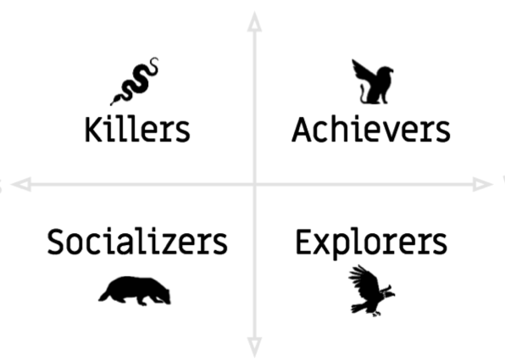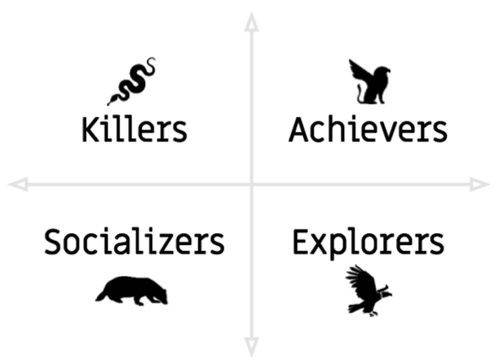February 3, 2020
Learning is playing, playing is learning. It’s obvious when we think about kids. It’s how they learn new stuff, which makes games their way of developing. But then we grow up, and for some reason, “forget” how to play. We might even hear some adults say, “I don’t like to play games.”
I have some assumptions about why people might say it, but actually, I think it’s impossible for someone not to like playing games. How is this possible? From my point of view, people who say they don’t enjoy playing are people who never found the right kind of game they like to play or the right way for them to play. The fact is that there are lots of ways and types for playing, and most of us know very few of them. To understand it better, let’s look at Bartle’s taxonomy of player types:
Bartle recognizes four types of players in multiplayer online games. Those types are not only to describe those players, but according to this deviation, you can identify what motivates people to play. In general:

The achievers are the classic players, as we know them- they like to earn points, to achieve trophies and badges, and to feel like they are in progression.
The killers will do everything (!) to be the best ones and they want everyone to know they are the best. If someone got the first place before they did and there’s no way to replace him- they would lose interest in the game.
The socializers are here for the company. They enjoy working together with others, they like to do things in groups and want to be meaningful for others in the group.
The explorers are in the game for the magic of discovering new things. They like to know things others don’t know (and mostly don’t really want to know).
This theory was written about multiplayer online games, and ever since it was published, more theories expanded the idea of dividing players into groups and types. I find this taxonomy relevant to other games and even to other areas in life because it’s about what motivates people to do things.
When it comes to designing for learning, I think about the taxonomy as a tool for what motivates people to learn. So, here is my interpretation of Bartle’s taxonomy for types of learners, and practical example for the specific type of player:
The achievers want to do all the assignments the best way they can. They couldn’t care less what others think or do as long as they get 100% of the score. It’s easy to design for them because they are the classic type of player who is motivated by PBL. As long as they see points, badges, and leaderboard in front of them, they are motivated to continue- until they have the entire set of badges and 100% of the points.
The achievers don’t care to share the first place, so the leaderboard is something that makes them feel a sense of progression. However, as a motivator the leaderboard is more significant for the killers:
The killers must be the first and the best. The killer is the one who doesn’t care to get 60% of the score, as long as everyone else gets 59% or less. In other words- as long as they are at the top of the leaderboard table.
They won’t spend their time on extra activity because it’s in their way to victory, and they will lose interest when they see someone else already got the first place.
Weirdly (or not so weirdly), that is kind of what makes them socializers- the killers can’t learn alone because they need other people to compare themselves to.
My suggestion, if you recognize you have lots of killers-type, it’s better to create a few different kinds of scores and paths to excel in order to give them lots of opportunities to shine. Another way is creating a dynamic leaderboard in which the first place can be changed. Otherwise, as soon as one got the first place, they will lose interest in the material.
The socializers are people persons. They like to work in groups, to share answers with others, to be a part of a team. They need to feel meaningful for the group and good at the role they have inside the group. Otherwise, they can feel like they failed the entire group, which can make the socializer feel a sense of guilt.
This kind of learner likes to do a study group and solve things together. So my suggestion for designing a learning process for a group with lots of socializers is not only to make them work in groups but also give them a meaningful role as a part of the group. “Six Thinking Hats” of Edward de Bono is an excellent example of providing roles inside the group. Another option is, if possible, phrase the question as something meaningful. Storytelling might help you do it.
The explorers are learners by default. They are curious individuals who like to research, discover new (and hidden) things, and to understand how things work backstage. Their joy is to know something others don’t know, even if it’s not essential to the material and even far away from the learning goals.
For a group of learners in which most are explorers, you can give a list of questions for them to find the answers to, and if those questions look like a riddle – they would be so excited that they might forget the fact that they are in a learning process.
Now, the question is, how would we know which type of learners we have in our group? Which kind do we need to design for?
There is no magic answer, but no matter what, it’s important to balance between the different types. We should design for every kind of learner, for two reasons:
First, we have one dominant motivation, which means we don’t have 100% from one type, but some from each type. I can be 73% socializer, 65% killer, 47% explorer, AND 27% achiever.
Second, if you have more than ten learners to design for, it’s very likely you need to plan for all types of learners.
Also, this idea came from the need to expand the way we look at our learners. It might seem like we define them and put them inside a box with a specific title, but I wish that this will help us think about our learner motivation more deeply and that it will give us more tools to design enjoyable and meaningful learning.
Nowadays, my colleague and friend Hadar Bar David and I are developing a tool that will help us assess, and analyze the different types of learners using a questionnaire.
Want a little challenge? Hadar and I hid a little Easter egg in the article. Another way of looking at the type of learners in the framework of motivation. Can you find it?
If you want to share your answer or get another hint, you are welcome to do so with the hashtag #play2learn and tag Hadar Bar David or me (Zofia Einhorn), or send us a message.
By the way, can you tell which kind of learners will be motivated to look for this easter egg, and which one would like to answer this question?

